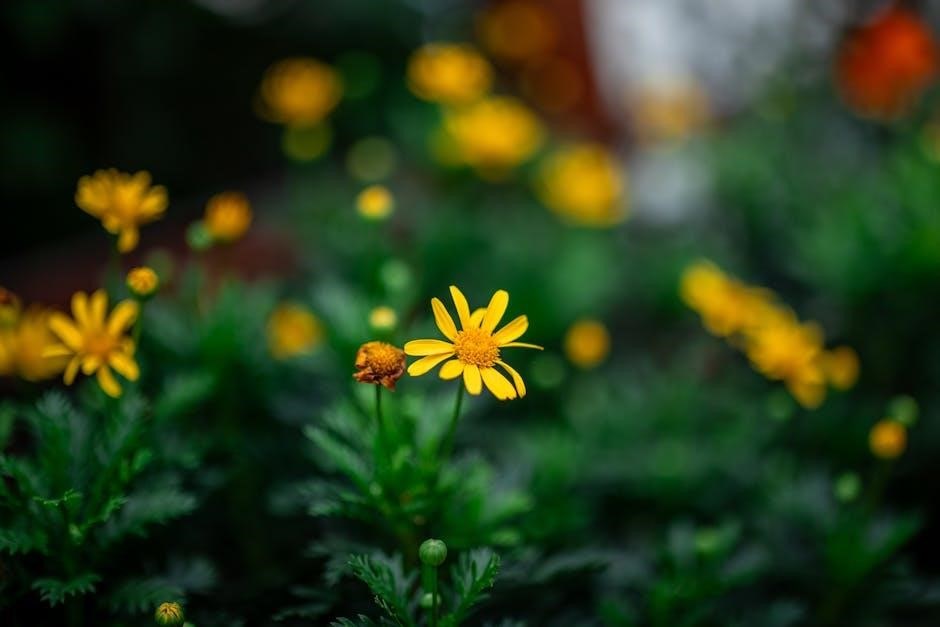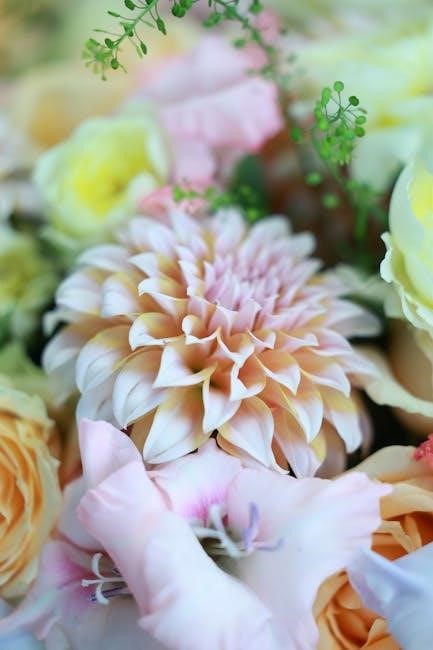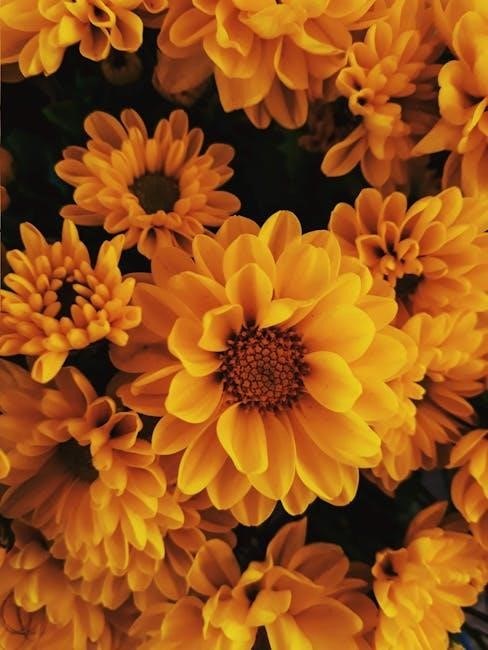The chrysanthemum‚ a flowering plant native to Asia and Europe‚ symbolizes longevity and honor․ As Japan’s national flower‚ it holds cultural importance and is used in traditional medicine and ornamental displays․
Cultural and Historical Significance
The chrysanthemum holds profound cultural and historical significance‚ particularly in East Asian cultures․ Originating in China‚ it was introduced to Japan in the 8th century and became a symbol of longevity‚ honor‚ and royalty․ In Japan‚ the chrysanthemum crest‚ or kikukamon‚ represents the Imperial Family‚ embodying the emperor’s divine authority․ It also appears in traditional art and literature‚ reflecting its enduring importance․ Ruth Benedict’s The Chrysanthemum and the Sword explores Japan’s cultural duality‚ symbolized by the flower and the warrior’s sword‚ highlighting its role in shaping national identity and social values․
Botanical Overview
The chrysanthemum is a flowering plant in the Asteraceae family‚ with over 40 species native to Asia‚ Europe‚ and North America․ It is known for its vibrant‚ showy flowers‚ which bloom in shades of yellow‚ white‚ pink‚ and red․ The plant grows as a perennial‚ typically reaching heights of 1 to 3 feet‚ and thrives in well-drained soil and full sun․ Chrysanthemum coronarium and Chrysanthemum morifolium are among the most cultivated species‚ valued for their ornamental and medicinal properties․ Its volatile oils‚ flavonoids‚ and polysaccharides contribute to its use in traditional medicine and as a source of essential oils․
Chrysanthemum in Literature
The chrysanthemum has inspired numerous literary works‚ symbolizing cultural identity and personal growth․ Kevin Henkes’ Chrysanthemum explores self-acceptance‚ while Ruth Benedict’s The Chrysanthemum and the Sword examines Japanese culture․
Kevin Henkes’ “Chrysanthemum”
Chrysanthemum by Kevin Henkes is a heartwarming children’s book published in 1991․ It tells the story of a young girl named Chrysanthemum‚ who struggles with her unique name and the teasing she endures at school․ The story follows her journey of self-acceptance and the support she receives from her family and a wise teacher․ The book is celebrated for its gentle narrative and positive message about individuality․ It has become a beloved classic‚ resonating with readers of all ages and highlighting the importance of kindness and understanding․

Ruth Benedict’s “The Chrysanthemum and the Sword”
The Chrysanthemum and the Sword by Ruth Benedict is a groundbreaking anthropological study of Japanese culture‚ published in 1946․ It explores the dualities of Japanese society‚ symbolized by the chrysanthemum (representing emperor and tradition) and the sword (symbolizing honor and militarism); Benedict examines the cultural contrasts‚ such as the coexistence of rigid etiquette and deep emotional sensitivity․ The book provides a comprehensive understanding of Japan’s complex social structures and values‚ offering insights into the nation’s identity and behavior during World War II․ It remains a seminal work in cultural anthropology and Japanese studies․
Chrysanthemum as a Symbol

The chrysanthemum symbolizes longevity‚ honor‚ and fidelity‚ representing the emperor and Japan’s cultural heritage․ It embodies optimism‚ longevity‚ and timeless beauty‚ making it a cherished symbol globally․

The Imperial Family of Japan
The chrysanthemum is deeply intertwined with Japan’s Imperial Family‚ serving as their official crest․ This 16-petaled “Imperial Chrysanthemum” symbolizes the emperor’s divine lineage and authority․ Historically‚ it appears on the Imperial Seal and is reserved for imperial use‚ reflecting its sacred status․ The chrysanthemum’s enduring beauty and resilience mirror the monarchy’s continuity‚ making it a powerful emblem of Japanese heritage and sovereignty․ Its presence in ceremonies and official emblems underscores its cultural and historical significance‚ embodying the essence of Japan’s imperial tradition and identity․
National Flower of Japan
The chrysanthemum is celebrated as Japan’s national flower‚ alongside the cherry blossom․ Its significance extends beyond symbolism‚ representing longevity and honor in Japanese culture․ The flower’s popularity endures through its vibrant blooms and varied colors․ Additionally‚ it plays a role in traditional medicine and is a staple in ornamental arrangements․ Its beauty and resilience make it a cherished emblem‚ reflecting Japan’s rich cultural heritage and its deep appreciation for nature’s splendor․ The chrysanthemum’s enduring presence in Japanese traditions underscores its importance as a national symbol‚ cherished by people across generations․

Cultivation and Care
Chrysanthemums thrive in well-drained soil and full sun․ Regular deadheading promotes blooms․ Protect from extreme weather and pests for optimal growth and vibrant flower displays․
Step-by-Step Crochet Patterns
Propagation Methods
Chrysanthemum propagation involves methods like stem cuttings‚ division‚ and layering․ Cuttings from healthy stems are ideal for rooting‚ while dividing established plants ensures genetic consistency․ In vitro propagation is also effective‚ using explants in controlled media․ Tissue culture techniques enhance plant multiplication‚ maintaining desirable traits․ Proper care‚ including adequate light and water‚ supports successful growth; These methods are widely used in both commercial and home settings to cultivate this versatile flower‚ valued for its ornamental and medicinal properties․ Detailed guides and PDF resources are available online‚ offering step-by-step instructions for gardeners and researchers alike․

Health Benefits
Chrysanthemums are rich in flavonoids and volatile oils‚ offering antioxidant and anti-inflammatory properties․ They are used in traditional medicine to treat hypertension and respiratory issues‚ promoting overall wellness․
Traditional Chinese Medicine
Chrysanthemum is a cornerstone in traditional Chinese medicine‚ valued for its health-promoting properties․ The plant contains bioactive compounds like flavonoids and volatile oils‚ which are known to reduce inflammation‚ improve cardiovascular health‚ and boost the immune system․ In TCM‚ chrysanthemum is often consumed as a tea or used in herbal formulations to treat conditions such as hypertension‚ fever‚ and respiratory ailments․ Its cooling properties are believed to balance the body’s energy‚ or “qi‚” making it a popular remedy for seasonal discomforts․ The flower is also used to support eye health and alleviate stress‚ further highlighting its versatility in holistic wellness practices․

Nutritional Value
Chrysanthemum is packed with essential nutrients‚ including vitamins A and C‚ potassium‚ and dietary fiber․ Its flowers and leaves are rich in antioxidants‚ such as flavonoids and phenolic acids‚ which help combat oxidative stress and inflammation․ The plant also contains polysaccharides‚ known for their immune-boosting properties․ Chrysanthemum tea‚ a popular beverage‚ is low in calories and caffeine‚ making it a healthy choice for hydration․ Its nutritional profile supports heart health‚ digestion‚ and immune function‚ while its anti-inflammatory compounds may reduce the risk of chronic diseases․ This versatile flower is not only ornamental but also a valuable source of wellness-promoting nutrients․
Diseases and Pests
Chrysanthemums are susceptible to Fusarium wilt and Chrysanthemum Stem Necrosis Tospovirus‚ causing yellowing leaves and plant death․ Regular monitoring and disease management practices are essential for healthy growth․
Fusarium Wilt
Fusarium wilt‚ caused by the fungus Fusarium oxysporum‚ is a common disease affecting chrysanthemums․ Initial symptoms include yellowing and browning of leaves‚ progressing to wilting and plant death․ The fungus thrives in warm‚ moist soil and can spread through contaminated water or tools․ Prevention methods include using resistant varieties‚ practicing crop rotation‚ and ensuring good drainage․ Infected plants should be removed immediately to prevent further spread․ Treating with fungicides can help manage the disease‚ but early detection is critical for effective control․ Regular monitoring and proper sanitation are essential for maintaining healthy chrysanthemum crops․
Chrysanthemum Stem Necrosis Tospovirus
Chrysanthemum stem necrosis tospovirus (CSNV) is a damaging viral disease affecting chrysanthemums worldwide․ It causes necrosis‚ yellowing‚ and stunting of plants‚ leading to significant yield loss․ The virus is transmitted by thrips and thrives in temperate climates․ Countries like Italy‚ Brazil‚ Iran‚ and Japan have reported its spread․ Early detection is crucial‚ as infected plants often cannot be cured․ Management strategies include removing infected plants‚ using virus-free cuttings‚ and controlling thrips populations․ This disease poses a major threat to commercial chrysanthemum crops‚ emphasizing the need for strict sanitation and pest control measures to prevent outbreaks and protect plant health․

Digital Publications
PDF Flipbooks
Interactive Digital Platforms

Economic Importance
Chrysanthemums are a significant commercial crop‚ valued in the ornamental industry and traditional medicine․ They are the second-most important plant in these sectors‚ driving economic growth globally․
Ornamental Industry
Chrysanthemums are a cornerstone of the ornamental industry‚ serving as a major commercial crop and popular exhibition flower․ Their vibrant blooms and diverse shapes make them ideal for cut flower arrangements‚ bouquets‚ and home decor․ Available in a wide range of colors and sizes‚ they are widely used in floral decorations for events and celebrations․ Their versatility and beauty have made them a favorite among florists and gardeners worldwide․ Additionally‚ their long-lasting flowers contribute to their popularity in the global cut flower market‚ making them a significant contributor to the ornamental sector’s economic growth and cultural significance‚ particularly in Asian countries․
Commercial Crop
Chrysanthemums are cultivated as a valuable commercial crop‚ particularly for their flowers‚ which are in high demand for floral arrangements and exhibitions․ Their versatility and wide range of colors make them a popular choice for florists and event planners․ Beyond ornamentation‚ chrysanthemums are also grown for their use in traditional medicine and essential oils․ The global market for chrysanthemums is substantial‚ with significant production in Asia‚ where they are both a cash crop and a culturally significant plant․ Their economic importance extends to supporting livelihoods in agriculture and related industries‚ making them a key player in the horticultural economy worldwide․
